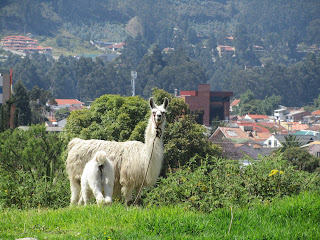
With a last wistful look back at Ecuador, we crossed the border into Peru to begin the next leg of our adventure. In doing so, we would encounter greater distances, far more tourists, higher prices, and new landscapes. Since Peru is huge, almost twice the size of Texas, we really had to prioritize what we wanted to see and do. So we made the painful decision to skip the northern Peruvian coast, with its mysterious ruins and rugged towns, and jump on an 18 hour bus to Lima. Andean highlands turned to flat coastal desert as we crossed the border and, after a quick stop in Piura to shave Oliver´s increasingly unruly beard, we nervously boarded our first overnight, and longest to date, bus. After encountering a wide range of buses in terms of quality and reliability, we decided to splurge on the ritzy Cruz del Sur, a two-tiered cruiser with (almost) fully reclining seats, dinner service, WIFI, movies, and bingo! (Although the numbers came much faster than we could possibly translate and then find on our boards so, no, we didn´t win.) We arrived in Lima the next morning still tired and with low expectations for the city we´d been told was dirty, dangerous, and not worth the stop. What we found, however, was a diverse metropolis with a modern edge, a foot in the past, and really good food. We would stay in Miraflores, an upscale district of fantastic restaurants and beautiful parks. However, our hunt for indigenous ruins would take us through the underbelly of Lima, miles and miles of shanty towns just outside the city. While we have seen poverty before, never on such a large scale. The contrast between the prized districts of central Lima and these forgotten squalors was astounding.
Top on our lists of ruins was the citadel of Pachacamac, the most important religious site on the Peruvian coast for over 1500 years and an enormous complex of temples, oracles, houses, etc. from different periods of time and cultures. As no English-speaking guides were available (we couldn´t afford one anyways) we decided to play archaeologists and "discover" this vast area for ourselves. Pachacamac, or "Earth-maker", was a feared god who could cause earthquakes and other cataclysms, and the temples were built in his honor. The oracles were consulted by chiefs from all over the Andes and as each culture came to power, they built upon the others, concluding with the dominating Incan Sun Temple. Needless to say, the site was quite impressive.
Closer to our hostel, we also visited the ruins of Huaca Pucllana, a site of adobe pyramids and houses constructed in the 6th century A.D. The largest structure is 500 meters in length, more than 100 meters wide and 22 meters high, in a massive pyramid style. Comprised of small adobe bricks set in a "bookcase" style and numbering in the hundreds of thousands, the entire ruin is surrounded by the modern city of Lima, making the contrast between the old and the new ever-present.
Our time in Lima was not entirely spent on archaeology, however. We soaked up plenty of metropolitan life, going to the movies (in English with Spanish subtitles!), shopping, and gorging at the delicious restaurants of Lima. The highlight would be our splurge visit to Astrid & Gaston, where we would try such local delicacies as alpaca and cuy, or guinea pig, and delicious cocktails crafted with pisco, the national drink of Peru. Our favorite South American capital so far, Lima satiated our minds, sense of adventure, and bellies.
 |
| No more beard! and the coast of Lima. |
 |
| Oliver "discovering" the temple of virgins at Pachacamac. |
 |
| Laura "discovering" the Temple of the Sun at Pachacamac. |
 |
| Laura worshipping the sun god atop the pyramid. |
 |
| Oliver even found some artifacts! |
 |
| The archaeological duo at work! |
 |
| Random jazz-ercize class on a closed street in Miraflores. |
 |
| Huaca Pucllana with Lima in the background. |
 |
| Atop one of the many structures in Huaca Pucllana overlooking Lima. |




























































